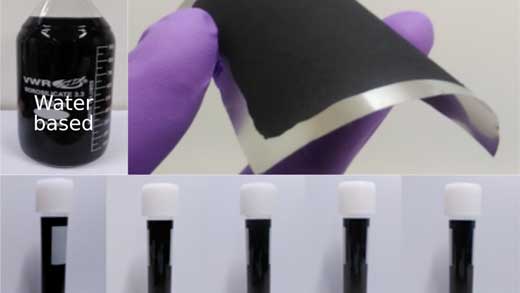| Apr 07, 2020 | |
Physicists produce stable water-based graphene dispersion(Nanowerk News) Umeå researchers show how activated graphene, activated carbons and other hydrophobic carbons can be dispersed in water in a form of micrometer-sized particles. The key agent that helps to make these dispersions last for days is the oxidized form of graphene named graphene oxide (Journal of Physical Chemistry Letters, "Aqueous Activated Graphene Dispersions for Deposition of High Surface Area Supercapacitor Electrodes"). The authors have applied for patent for the method to prepare dispersions. |
|
| Graphene, graphite, activated carbons are quite different forms of carbon but what is common for them is their hydrophobic properties. It is impossible to dissolve or disperse these materials in water directly. On the other hand, using dispersions or solutions for many applications is a big advantage. Ideally, one can spray or paint graphene dispersion on metal foil and prepare e.g. electrode material by simply drying. | |
| Scientists have been searching for good methods to prepare dispersions using graphene-related materials for many years. The most common method available so far is to use organic solvents and very strong mechanical treatment, e.g. sonication for long time. However, organic solvents are often toxic while mechanical treatment is not only time and energy consuming but also introduces many defects, which adversely affect conductivity of the graphene sheets. | |
| Researchers from Umeå University have found a simple and environmentally friendly solution to the problem: oxidized form of graphene, graphene oxide, is hydrophilic and easy to disperse in water. | |
 |
|
| Dispersion with oxidised graphene, day 1-10. (Image: Nicolas Boulanger) | |
| “What we discovered is that stable water dispersions can be prepared by adding certain amount of graphene oxide to various hydrophobic carbons”, says Alexandr Talyzin, Associate Professor at the Department of Physics at Umeå University. | |
| His team of physicists tested the method using high surface area carbons like graphene, activated graphene, porous or activated carbons. The dispersions were stable and did not precipitate even after days of shelf storage. When they added some carbon nanotubes into the dispersion, it appeared to be rather good for preparation of supercapacitor electrodes. The dispersion was applied to metallic foil, dried and heated at 200o Celsius. All these steps could easily be scalable into industrial production, the researcher suggest. | |
| “What we get in the end is a thin film of conductive electrode material with rather high surface area, good conductivity and excellent performance in storage of electricity in supercapacitors. The high surface area is provided by the micrometer-sized particles of e.g. activated graphene, while nanotubes and thermally reduced graphene oxide provide good electrical contact between the particles”, says Alexandr Talyzin. | |
| The dispersions can be useful also in many other applications like inks for printing, protective coatings, and conductive paints. | |
| The research is funded by the EU Graphene Flagship, a huge international project aimed at bringing graphene to the market. Researchers have also received much support from Umeå University. The method for preparation of activated graphene dispersions also appears to be worth to patent. | |
| “It went surprisingly smooth and rapid once I contacted Innovation Office at Umeå University. We got enormous amount of help in short time thanks to experts like Daniel Hoffman and his colleagues. While the scientific paper was under reviewing, we were able to complete the application for a patent”. |
| Source: Umeå University | |
|
Subscribe to a free copy of one of our daily Nanowerk Newsletter Email Digests with a compilation of all of the day's news. |
